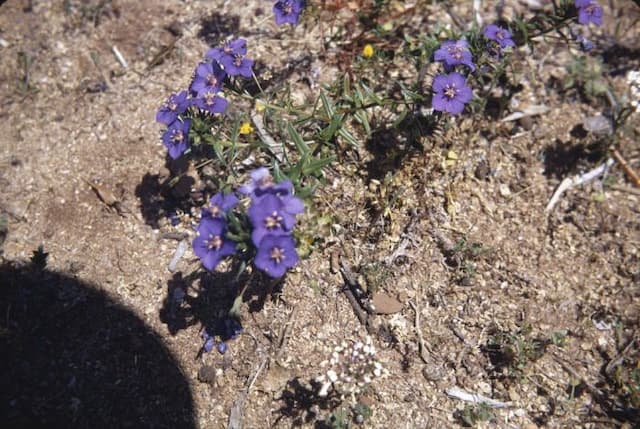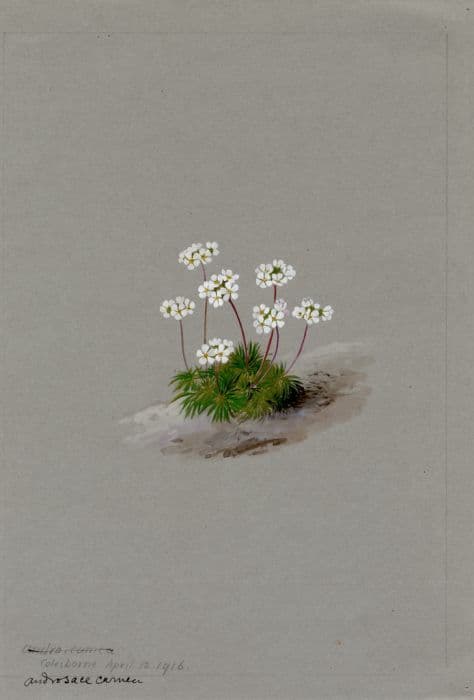Shooting Star Dodecatheon pulchellum subsp. pulchellum 'Red Wings'

ABOUT
The plant known as 'Red Wings' is a striking wildflower with a distinctive appearance. The most striking feature is its blooms, which resemble shooting stars, with swept-back petals in a rich reddish-pink color surrounding a central tube of the same hue but with a deeper tone. The petals create a dramatic contrast against its bright yellow stamens, which stand out boldly at the center. This showy display sits atop thin, wiry stems, which emerge from a rosette of lush green leaves. The foliage is lance-shaped, gently tapering to a point, and forms a basal cluster. 'Red Wings' possess a delicate beauty, with its nodding flowers providing a lively burst of color during its blooming season.
About this plant
 Names
NamesSynonyms
Red Wings Shooting Star, Pretty Shooting Star, Dark Throat Shooting Star, Wild Cyclamen.
Common names
Dodecatheon pulchellum var. pulchellum, Dodecatheon affine, Dodecatheon pauciflorum, Dodecatheon pulchellum, Primula pauciflora.
 Toxicity
ToxicityTo humans
The plant commonly known as shooting star is not known for being particularly toxic to humans. However, as with any plant, individual sensitivity may vary, and it is generally advisable to avoid ingesting parts of ornamental plants due to the potential presence of harmful substances that could cause adverse reactions. If ingestion does occur and symptoms present, it would be prudent to seek medical advice.
To pets
The plant commonly known as shooting star is not specifically listed as toxic to pets. However, caution should be exercised as individual animals might have sensitivities or allergic reactions to plant materials not typically considered poisonous. If a pet does ingest parts of this plant and exhibits signs of distress such as vomiting, diarrhea, or unusual lethargy, it is important to consult with a veterinarian.
 Characteristics
CharacteristicsLife cycle
Perennials
Foliage type
Deciduous
Color of leaves
Green
Flower color
Red
Height
1 foot (30 cm)
Spread
1 foot (30 cm)
Plant type
Herb
Hardiness zones
4
Native area
North America
Benefits
 General Benefits
General Benefits- Attractive Flowers: Produces striking reddish-pink flowers that add vibrant color and beauty to any garden or landscape.
- Pollinator-Friendly: Flowers attract bees, butterflies, and other pollinators, supporting local ecosystems.
- Easy to Grow: Adapts well to a variety of soil types and garden conditions, making it an easy plant for gardeners of all levels.
- Seasonal Interest: Offers aesthetic appeal during its blooming season in spring and early summer.
- Drought Tolerance: Once established, it has a good level of drought tolerance, requiring less water compared to many other plants.
- Naturalizing: Can spread and naturalize in an area over time, creating larger displays of color without needing to replant.
- Wildlife Habitat: Provides food and habitat for various species of insects and animals enhancing biodiversity.
- Durable: Capable of surviving colder temperatures and harsher conditions, making it suitable for various climates.
 Medical Properties
Medical PropertiesThis plant is not used for medical purposes.
 Air-purifying Qualities
Air-purifying QualitiesThis plant is not specifically known for air purifying qualities.
 Other Uses
Other Uses- Shooting Star 'Red Wings' can be used as a natural dye source, providing a range of colors from the flowers and roots for fabrics and yarns.
- In small-scale landscaping, the Shooting Star is suitable for fairy gardens due to its delicate appearance and interesting floral structure.
- Its colorful and unique flowers can be used in pressed flower art, holding their shape and beauty in between sheets of glass or in books.
- Shooting Star can be a subject for botanical illustration classes, providing a complex and interesting form for artists to capture in detail.
- This plant's dried seed pods can be used in decorative dried flower arrangements or as a component in creating botanical jewelry.
- Educational programs can use the Shooting Star to teach about pollination and the co-evolution of plants and their pollinators such as bees.
- Photographers may use Shooting Star 'Red Wings' in their compositions for nature photography, capturing the striking contrast of its vivid flowers against natural backgrounds.
- Gardeners interested in phenology, the study of cyclic and seasonal natural phenomena, can use the plant as an indicator species for the start of spring.
- Conservationists may utilize Shooting Star as part of native plant restoration projects to support local ecosystems and biodiversity.
- In culinary presentation, although not commonly eaten, the blooms can be used as a non-toxic garnish to elegantly decorate desserts and salads.
Interesting Facts
 Feng Shui
Feng ShuiThe plant Shooting Star is not used in Feng Shui practice.
 Zodiac Sign Compitability
Zodiac Sign CompitabilityThe plant Shooting Star is not used in astrology practice.
 Plant Symbolism
Plant Symbolism- Pride: Commonly known as Shooting Star, Dodecatheon pulchellum subsp. pulchellum 'Red Wings' symbolizes pride due to its unique, pointed shape that seemingly shoots up from the stem, standing tall and proud amongst other flora.
- Guidance: As its name suggests, the Shooting Star plant is often associated with guidance and direction, alluding to the celestial stars that have been used for navigation throughout history.
- Overcoming Challenges: The plant can also represent overcoming difficulties or challenges, much like its star-like flowers that "shoot" through the air, implying a breakthrough or triumphant moment.
- Wishes and Dreams: Similar to how people make wishes on shooting stars, the Shooting Star plant is tied to wishes, hope, and the fulfillment of dreams, encouraging one to chase their aspirations.
- Beauty in Simplicity: The elegance of the Shooting Star's simple shape is seen as a symbol of finding beauty in simplicity and appreciating the understated aspects of life.
 Water
WaterThe Shooting Star 'Red Wings' prefers consistent moisture, especially during spring and early summer, when it is actively growing. Water the plant once or twice a week, providing about 1 inch of water each time. Ensure the soil is well-draining to avoid waterlogging. During its dormancy in the late summer, reduce watering significantly, mimicking the natural dry season it would experience in its native habitat. Provide minimal water just to prevent the soil from completely drying out, which might be a light watering every few weeks, depending on the climate.
 Light
LightShooting Star 'Red Wings' grows best in partial shade to full sun. It thrives under the dappled sunlight of a woodland setting, but can also tolerate direct morning sun with afternoon shade. Avoid placing it in an area that receives harsh midday sun, as this can cause stress to the plant, leading to leaf scorch or faded blooms.
 Temperature
TemperatureShooting Star 'Red Wings' is hardy and can tolerate a range of temperatures but does best between 60°F and 75°F. Its tolerance for cold extends down to around 20°F, making it suitable for many temperate climates. During the growing season, protect the plant from extreme heat above 80°F, which can cause damage to its delicate foliage and flowers.
 Pruning
PruningPrune Shooting Star 'Red Wings' to remove spent flowers and dead foliage, which encourages a tidier plant and may promote a second bloom. The best time for pruning is after flowering has finished, usually in late spring to early summer. Pruning is not often necessary but can be done annually if needed to maintain the plant's shape and health.
 Cleaning
CleaningAs needed
 Soil
SoilFor Shooting Star 'Red Wings', a well-draining soil mix is essential; combine equal parts loam, sand, and peat for optimal growth. The soil pH should ideally be slightly acidic to neutral, around 6.0 to 7.0.
 Repotting
RepottingShooting Star 'Red Wings' should be repotted every 2-3 years, or when it outgrows its current container, to ensure continuous nutrient availability and root space.
 Humidity & Misting
Humidity & MistingShooting Star 'Red Wings' prefers moderate humidity levels; aim for around 40-60% relative humidity for optimal plant health.
 Suitable locations
Suitable locationsIndoor
Ensure bright indirect light and cool temperatures for indoor Shooting Stars.
Outdoor
Place in dappled shade; protect from harsh sun and heavy soil.
Hardiness zone
4-9 USDA
 Life cycle
Life cycleDodecatheon pulchellum subsp. pulchellum 'Red Wings', commonly known as 'Red Wings' shooting star, begins its life as a seed, which germinates in moist, cool conditions typically found in its native habitats. After germination, the seedling develops a rosette of basal leaves during the first growing season, drawing energy from the soil to build a strong root system. In the following spring, the plant enters a vegetative stage and continues to mature, with the leaves growing larger and the root system expanding. Once mature enough, the 'Red Wings' shooting star produces its characteristic flowering stems that bear the striking magenta to dark pink flowers with reflexed petals and a protruding stamen column, usually in late spring to early summer. After pollination, often by native bees or other pollinators, the flowers develop into capsules containing numerous tiny seeds, which are dispersed by wind or rain. The plant then enters a period of dormancy during the colder months, with above-ground parts dying back, and it relies on its perennial root system to survive until the next growing season.
 Propogation
PropogationPropogation time
Spring to early summer
The Dodecatheon pulchellum subsp. pulchellum 'Red Wings', commonly known as Shooting Star 'Red Wings', is typically propagated by seed. The best time for sowing seeds of the Shooting Star 'Red Wings' is in autumn. You would sow the seeds directly into a cold frame or a nursery bed as they require a period of cold stratification to break dormancy. Seedlings usually emerge when conditions are favorable in spring. Care should be taken not to cover the seeds too deeply, as they need light for germination, so a thin layer of soil or simply pressing them onto the surface is sufficient. Once the seedlings have grown sufficiently and can be handled, they should be pricked out and potted on before being planted out into their final position.









